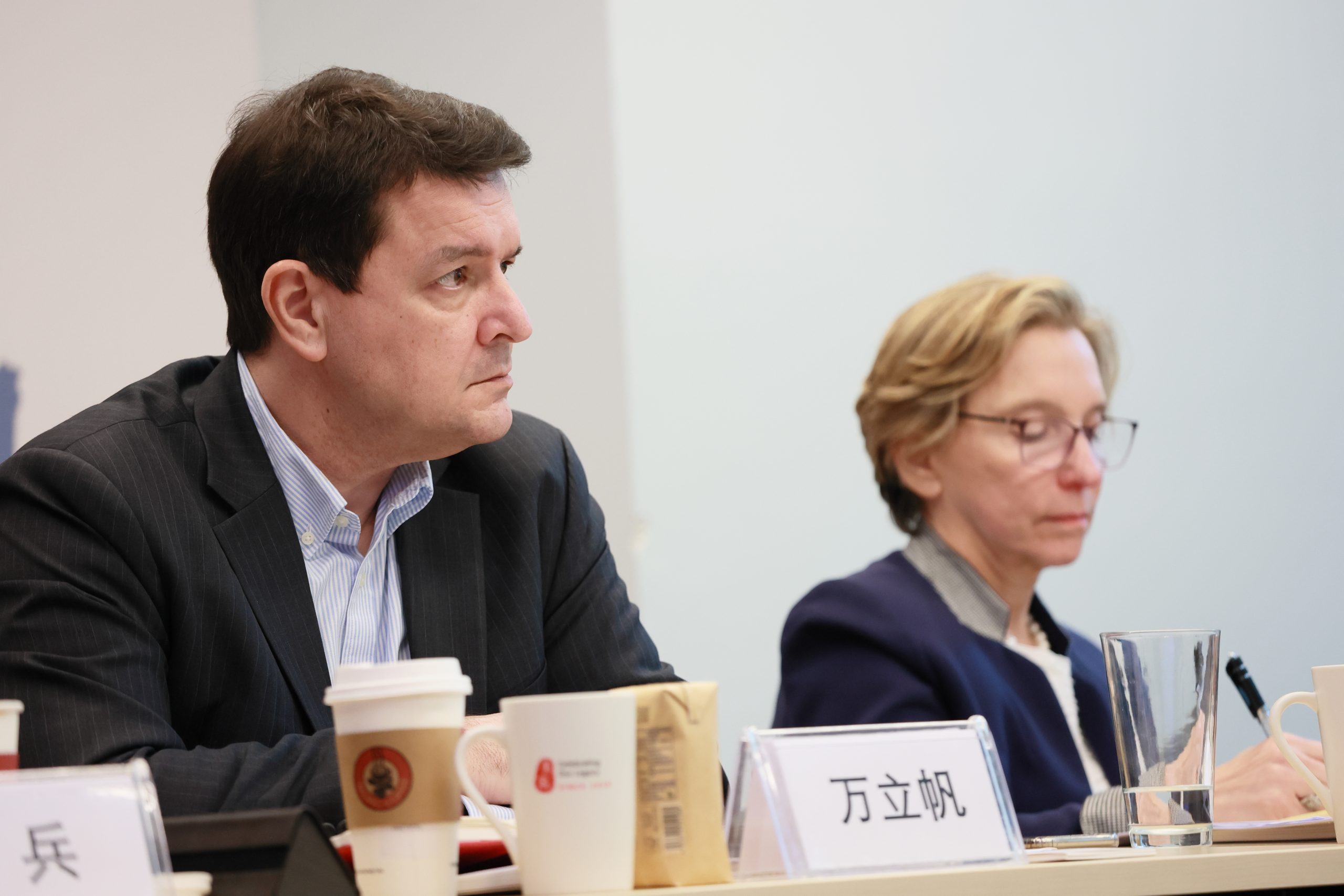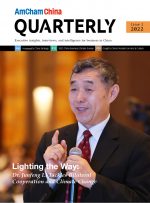ExxonMobil Outlines Ambitions for a Lower Carbon Future
By Norris Tangen
In January 2022, ExxonMobil unveiled plans to became a leader in energy transition, including its ambition to achieve net-zero emissions (Scope 1 and 2) by 2050 at its operated assets The AmCham China Quarterly caught up with ExxonMobil’s China Chairman Fernando Vallina to discuss the company’s commitment to China, its new net zero target, and the comprehensive approaches behind it.

Born in Spain, Fernando Vallina is a graduate of the Autonomous University of Madrid, where he earned a Bachelor of Science degree in chemistry. He also holds a Master of Business Administration degree from Instituto de Empresa (IE) in Spain. Vallina, who joined ExxonMobil Chemical in 1987, has held a wide range of management positions in sales, marketing, technology, planning and supply chain and has lived and worked in North America, Europe, the Middle East and Asia. Vallina was Asia Pacific sales and marketing manager for ExxonMobil Chemical Company, based in Hong Kong, from 1997 to 2001. He then served as its global logistics and distribution manager, before assuming the position of Chairman, ExxonMobil (China) Investment Co., Ltd. on March 1, 2017. Besides his role as a Governor of the Board of AmCham, Fenando is currently a member of the Board of the Association of International Chemical Manufacturers (AICM), and the Executive Board of the Multinational Companies’ Committee of China Petroleum and Chemical Industry Federation (CPCIF).
Photo courtesy of ExxonMobil
Since Fernando Vallina joined ExxonMobil 35 years ago, the organization has expanded exponentially across China. He recalls his first visit to China, “the office we had in Shanghai – I don’t think we had more than 50 employees total.” Reflecting on the company’s enormous development since then, he observes that, “Today, we’ve grown our China footprint from that single office to more than 2000 employees and a business portfolio that spans the full spectrum of the industry.” That impressive portfolio runs the industry gamut, from upstream liquified natural gas (LNG), and downstream lubricants, to chemicals and technology centers. And, as Vallina explains, that expansion shows no sign of slowing down. “Last November, a final investment decision was made to proceed with a multi-billion-dollar chemical complex in the Dayawan Petrochemical Industrial Park in Huizhou, Guangdong Province. This project will supply high-quality products needed to meet the growing demand in China and contribute to the economic and social development of local communities.” Specifically, the project will also bring the estimated addition of 700 full-time jobs, 4,000 indirect jobs during operations, and more than 20,000 jobs during the peak construction period.
Vallina cites this this multi-billion-dollar investment as a manifestation of ExxonMobil’s longstanding and continuing commitment to its China operations. ExxonMobil’s China history dates back to 1892, when its predecessor, Standard Oil, began marketing kerosene to light Mei Foo lamps in Chinese homes. Since the country reopened its market to foreign participation in the late 1970’s, ExxonMobil has focused on gradually re-engaging in many aspects of China’s energy industry. Vallina feels confident in the company’s continuing and evolving presence here, affirming a strong belief that, “The China market continues to offer tremendous opportunity for further growth.” Referencing its extensive history in China, Vallina emphasizes the market’s importance to ExxonMobil, “Building on our strong heritage, together we will capture such opportunities, grow our business further and embrace a brighter future. We have operated in China for more than a century, and our commitment to this strategic market has not changed.”
Driving Down Emissions
When asked, Vallina eagerly delves into ExxonMobil’s commitment to sustainability initiatives. In January 2022, the company announced its ambition to achieve net zero greenhouse gas emissions (GHG), Scope 1 and 2, for operated assets by 2050. “Our strategy uses our advantages in scale, integration, technology, and people to build globally competitive businesses that lead in industry earnings and cash flow across a broad range of scenarios.” As ExxonMobil aims to achieve its net-zero goals by 2050, he adds that this requires a comprehensive approach, centered on developing detailed GHG emission-reduction roadmaps for major operated assets. He is confident about the resilience of both the business and strategy, pointing to an analysis using the International Energy Agency’s Net Zero Emissions by 2050 scenario. He predicts that, “We are well positioned to compete in these businesses by leveraging our capabilities and repurposing assets. As the energy system evolves, we can deliver shareholder value across a wide range of future scenarios.”
ExxonMobil 2050
As the world endeavors to meet ambitious climate goals, companies like ExxonMobil are reflecting this effort by evaluating and shifting practices. However, Vallina does not foresee primary energy demands dwindling anytime soon. “Underpinning future energy demand is economic growth driven by increasing population and growing prosperity. ExxonMobil leverages its core capabilities to meet society’s needs for products essential for modern life.” He adds, “We provide fuels and lubricants for transportation, cement and steel for construction, and the building blocks for a variety of important products, ranging from medical supplies to food packaging.” ExxonMobil is working to advance climate solutions, but recognizes that the industry will not “go green” overnight. Vallina characterizes that transformation as developing and deploying solutions that meet society’s needs, remarking, “Today, that means taking a leading role in providing the products that enable modern life, reducing our Scope 1 and 2 GHG emissions, and developing needed technologies to advance a lower-carbon emissions future.”
As far as ExxonMobil’s efforts on the energy transformation, Vallina returns to its recently announced 2050 targets, “The ambition is supported by roadmaps to evaluate and pursue emission-reduction opportunities ranging from small-scale operational changes to large-scale capital investments.” For a company like ExxonMobil, he says the move to a lower-emission future requires solutions that can be implemented at scale. The company expects to finalize those detailed roadmaps – which are anticipated to address approximately 90% of operations – by the end of the year, with the remainder to be completed in 2023. Additionally, over the next six years, ExxonMobil has announced plans to invest more than $15 billion USD on initiatives to lower greenhouse gas emissions. Vallina says this significant increase will serve to further the company’s efforts to reduce the emissions from its operated facilities.
Ultimately, however, Vallina recognizes that there is no one-size-fits-all approach to climate change, saying, “There’s no one guaranteed approach to addressing climate change and reaching the goals laid out in the Paris Agreement.” However, while he accepts the challenges as the company works towards a more sustainable future, he also feels confident about the future. “ExxonMobil and many other organizations,” he says, “are working in partnership to address these challenges today and in the future. Together, we’re researching innovative technologies and solutions, like carbon capture and biofuels, to meet the growing demand for energy while mitigating the risks of climate change.”

Vallina attends an AmCham China event
Photo by Jin Peng
Comprehensive Approaches
ExxonMobil’s efforts to reduce their environmental impact are part of a massive global initiative. Vallina identifies what he refers to as the “dual challenge,” and calls it one of the most important issues the company must tackle. That dual chanllenge is, “meeting the world’s growing demand for energy and products that support modern life, while reducing environmental impacts, including the risks of climate change.” While global goals unite ExxonMobil’s efforts, the company tailors initiatives and goals to regional and country markets. In the upstream energy sector, for example (which involves points of production that originate early on in the processes and includes companies who identify, extract, or produce the raw materials), Vallina says ExxonMobil has been supplying cleaner-burning LNG to the Chinese market through two long-term agreements signed in 2009 with Sinopec and PetroChina, respectively. In 2019, a sales and purchase agreement was signed with Zhejiang Provincial Energy Group to supply one million metric tons per annum of LNG over 20 years. Vallina views natural gas energy as a vital opportunity to satisfy the energy needs of global consumers while helping to mitigate the risks of climate change. “When considering life cycle emissions,” he says, “natural gas emits up to 60% less greenhouse gas and produces significantly fewer air pollutants than coal for power generation.” He continues, noting that, “Many national and state governments have recognized the contributions natural gas can make to reducing greenhouse gas emissions and have included transitioning to natural gas in their carbon-reduction programs.”
ExxonMobil is also working to on its Chinese “Green Program.” Vallina details how the “Green Program” works to provide advanced lubrication technology and innovative solutions that can help customers save on energy consumption, reduce GHG emissions, and increase productivity — which will also contribute to the sustainable development of the economy. He goes on to say that the core concept of the program is, “less leads to more.” He explains, “The program offers a comprehensive solution covering energy efficient products, professional services to optimize oil drain interval and energy efficiency, and reusable bulk packaging to minimize package waste disposal.”
On the chemical front, ExxonMobil is taking action to address plastic waste in the environment by increasing plastic recyclability recovery. Vallina says, “We are pursuing new advanced recycling initiatives in the US and Europe that set in motion opportunities to capture value from plastic waste at scale.” He continues, “In terms of Chinese efforts, in one of our trial projects with a film convertor in southern China, ExxonMobil jointly developed an upgraded solution which has higher mechanical strength and stronger environmental durability, making it easier to recycle mulch film. The customer has commercialized the product and successfully collected mulch film from pilot farms. The retrieved film is then re-pelletized into resin for use in other applications such as trash liners and secondary packaging, thus achieving a complete cycle from manufacturing, recycling to re-utilization. ”
Another aspect of ExxonMobil’s sustainability work is its new Low Carbon Solutions business, launched in early 2021, which is initially focused on carbon capture and storage (CCS), hydrogen and biofuels. The Low Carbon Solutions business is targeting high-emission sectors that are especially hard to decarbonize, such as power generation and industrial manufacturing. Vallina notes that it also takes advantage of ExxonMobil’s experience in producing hydrogen, “another energy source likely to play a critical role in the years to come.” Vallina says that ExxonMobil “is interested to explore the potential CCS collaboration opportunities with regulators and industry players to reduce carbon emissions.” Given the wide scope of its efforts in China, Vallina feels assured in the company’s strategies to reduce its environmental impacts, observing that,“With all of these efforts going on, we see ample opportunities for collaboration with stakeholders along the value chain here in China.”
Policy Advocacy – AmCham China’s Role
In addition to his role at ExxonMobil, Vallina also serves on the AmCham China Board of Governors. Considering the organization’s role in the US-China relationship, he reflects that “AmCham China has been playing an important role in the business environment improvement in China and promotion of sustainable US-China economic relations.” He shares that he is optimistic that in the future, AmCham China will continue its legacy by playing an important role in supporting policy advocacy, adding, “Supportive policies and regulatory frameworks are critical to enabling deployment and infrastructure development at the pace and scale needed to help meet the goals of the Paris Agreement.” He goes on to say that support can range from durable incentives that can be provided through a variety of mechanisms such as grants, tax credits, or low-interest loans; sustained, long-term government support for research and development; or establishing a market price on carbon that supports investments.

This article is from the AmCham China Quarterly Magazine (Issue 2, 2022). To access the entire publication for free, sign up on our member portal here.
